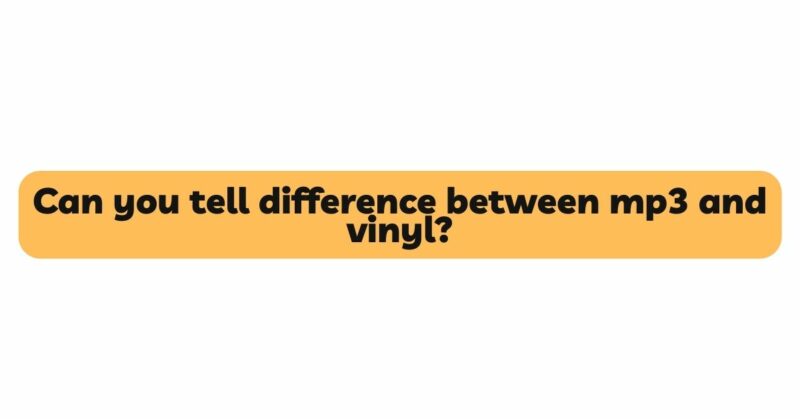In the ever-evolving realm of music consumption, the debate between digital and analog formats continues to spark fervent discussions among audiophiles, casual listeners, and music enthusiasts. At the forefront of this conversation are two distinct mediums: the ubiquitous MP3, a digital audio format that revolutionized portability, and the timeless vinyl, an analog format cherished for its authenticity and nostalgic charm. In this article, we embark on an in-depth exploration to uncover the fundamental differences between MP3 and vinyl, dissecting their sonic qualities, technological underpinnings, and the emotional experiences they evoke.
The Digital Magic of MP3
MP3, short for “MPEG-1 Audio Layer III,” represents a watershed moment in the history of music consumption. Its digital compression algorithm paved the way for efficient storage and transmission of audio files without significant loss of quality. Here’s a closer look at the defining attributes of the MP3 format:
- Compression Efficiency: MP3 employs lossy compression, which reduces file size by eliminating audio information that the human ear is less sensitive to. This allows for the storage of numerous songs on portable devices with minimal storage requirements.
- Portability and Accessibility: The compact nature of MP3 files enables users to carry their entire music libraries on devices such as smartphones, tablets, and portable media players. This level of accessibility transformed how people engage with music on-the-go.
- Digital Consistency: MP3 files maintain consistent audio quality across multiple playback devices, ensuring a uniform listening experience regardless of the equipment used.
- Instant Gratification: With the advent of digital music platforms, users can access and download MP3 files instantly, eliminating the need to visit physical stores or wait for shipments.
The Analog Splendor of Vinyl
Vinyl records, on the other hand, are revered for their analog authenticity and the tangible connection they offer to music. A blend of art and science, vinyl has maintained its allure across generations. Let’s delve into the distinct qualities that define vinyl’s appeal:
- Analog Warmth and Depth: Vinyl records capture the nuances of sound through analog grooves, resulting in a warm and depth-filled sonic character. The analog playback process introduces subtle imperfections like crackles and pops that contribute to a unique auditory experience.
- Dynamic Range: Vinyl enthusiasts champion the format’s expansive dynamic range—the difference between the softest and loudest sounds. Vinyl’s inherent limitations encourage careful mastering, resulting in a lifelike representation of the original recording.
- Tactile Engagement: The act of handling vinyl records, placing the stylus on the groove, and watching the turntable come to life adds a tactile and ceremonial element to the listening experience.
- Album Artwork and Collectibility: Vinyl’s larger canvas allows for intricate album artwork that is a visual extension of the music. The collectible nature of vinyl records fosters a culture of curation and appreciation.
Sound Quality Showdown: MP3 vs. Vinyl
Central to the MP3 vs. vinyl debate is the question of sound quality, influenced by the unique characteristics of each format:
- MP3 Sound Quality: While MP3’s lossy compression eliminates some audio data, it is designed to prioritize perceptually less important information. The result is a convenient compromise between file size and sound quality. The higher the bit rate (measured in kilobits per second or kbps), the better the audio quality, but even at higher bit rates, MP3 might not capture the nuances and dynamic range as faithfully as vinyl.
- Vinyl Sound Quality: Vinyl’s analog nature contributes to its rich and textured sound. However, vinyl’s sound quality is influenced by factors such as the quality of the record, the turntable, the cartridge, and the listening environment. High-quality vinyl setups can yield an immersive and authentic sound experience.
Emotional Resonance and Contextual Impact
Beyond technical specifications, the choice between MP3 and vinyl also involves emotional resonance and contextual considerations:
- Emotional Connection: Vinyl enthusiasts often value the nostalgia, ritual, and emotional engagement that vinyl records provide. The tactile experience of vinyl playback deepens the emotional bond between the listener and the music.
- Modern Lifestyle: MP3’s convenience aligns seamlessly with the demands of modern life. Portability, instant access, and a wealth of digital platforms cater to users’ preferences for quick and varied music consumption.
Conclusion
The comparison between MP3 and vinyl goes beyond objective analysis—it’s a matter of priorities, preferences, and the desired musical experience. MP3 offers digital convenience, portability, and accessibility, allowing users to carry their entire music libraries in their pockets. Vinyl, on the other hand, provides a sensory and nostalgic engagement with music, characterized by analog warmth and a ceremonial process.
Ultimately, the choice between MP3 and vinyl hinges on personal values and the desired experience. Each medium offers its own distinct advantages and resonates with different audiences. Whether you’re captivated by the digital marvel of MP3 or enchanted by the analog authenticity of vinyl, both formats contribute to the diverse tapestry of musical enjoyment, catering to a spectrum of tastes, lifestyles, and values. The decision, in the end, is yours to make, and both paths offer unique avenues to embark on an enriched auditory journey.


